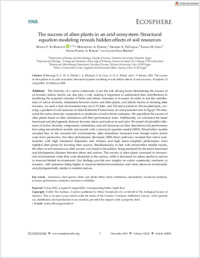The success of alien plants in an arid ecosystem: Structural equation modeling reveals hidden effects of soil resources
DOKPE
- El‐Barougy, Reham F. ORCID University of Fribourg
- Dakhil, Mohammed A. Helwan University, Cairo, Egypt
- ElGamal, Ibrahim A. Egyptian Environmental Affairs Agency, Cairo, Egypt
- Gray, Sarah M. ORCID University of Fribourg
- Khedr, Abdel‐Hamid A. Damietta University, Egypt
- Bersier, Louis‐Félix ORCID University of Fribourg
- 2021
Published in:
- Ecosphere. - Chichester, UK : Wiley. - 2021, vol. 12, no. 12, p. 1-16
abundance
alien species
biotic and abiotic filters
biotic relatedness
dissimilarity
functional similarity
invasion
performance
resistance
resources availability
English
The diversity of a native community is not the sole driving factor determining the success of an invader; abiotic factors can also play a role, making it important to understand their contributions in modifying the expected outcome of biotic and abiotic resistance to invasion. In order to test the contributions of native diversity, relatedness between native and alien plants, and abiotic factors in resisting alien invasion, we used a trait–environment data set of 33 alien- and 130 native plants in 166 invaded plots, covering a gradient of soil resources in Saint-Katherine-Protectorate, an arid-protected area in Egypt. We measured the native diversity components as predictors of native biotic resistance. We quantified the success of alien plants based on their abundance and their performance traits. Additionally, we calculated the mean functional and phylogenetic distance between aliens and natives in each plot. We tested all plausible influences of native diversity components, relatedness, and soil resources on alien abundance and performance first using mixed-effects models and second with a structural equation model (SEM). Mixed-effect models revealed that, in the resource-rich environments, alien abundance increased even though native plants were more productive, but alien performance decreased. SEM direct pathways revealed that native communities with high functional dispersion and richness and high mean-weighted performance traits repelled alien plants by lowering their success. Simultaneously, in line with mixed-effect models results, the effect of soil resources on alien success was found to be indirect, being mediated by the mean functional and phylogenetic distance between aliens and natives: The success of alien plants increased in resource-rich environments when they were dissimilar to the natives, while it decreased for aliens similar to natives in resource-limited environments. Our findings provide new insights on native community resistance to invasion, with resistance being higher in resource-limited environments and when aliens are functionally and phylogenetically similar to resident natives.
- Faculty
- Faculté des sciences et de médecine
- Department
- Département de Biologie
- Language
-
- English
- Classification
- Biology, life sciences
- License
- CC BY
- Open access status
- gold
- Identifiers
-
- DOI 10.1002/ecs2.3893
- ISSN 2150-8925
- Persistent URL
- https://folia.unifr.ch/unifr/documents/328696
Statistics
Document views: 21
File downloads:
- 2021_ecosphere_el-barougy.pdf: 98
